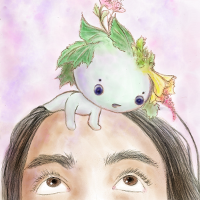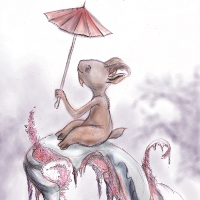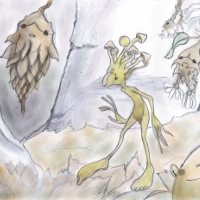 |
Information and stories on Japanese Gods
.
 |
|
Kami Home Fairy Tales Home Fairies Celtic Fairies Fairy Blog Finno-Baltic-Siberian Fairies Slavic Fairies
|
Japanese Fairy tales Oni Tengu Kitsune Tanuki  BISHAMON Bishamonten, or Bishamon, was also originally a Hindu god, whose Sanskrit name is Vaishravana. He is the god of wealth and one of the guardians of the four cardinal points of the universe. He is the guardian of the North. His other name is Kuvera. In Buddhism the four guardian-gods are differently named: East, Dhrtârashtra; West, Virűpâksha; Soutb, Virűdhaka; and North, Vaishravana. Some Hindu scholars say that this last-mentioned god did not play a very important part in the Hindu pantheon, and in spite of being Lord of Gold, no images or pictures p. 403 are to be had of him. As a Buddhist god he is well known and in Buddhist countries his pictures and images are plentiful. In the Japanese group of the seven gods Bishamon has lost his qualification as god of wealth. He is known only as the patron of knowledge, and it is in this capacity that he is sometimes called by the Japanese the God of Great Learning. Some of the great men in the history of Japan are believed to have been incarnations of this guardian of the North. Perhaps the Sanskrit name Vaishravana, which would be interpreted as being a derivative of the root shru, "to hear," might have suggested the rendering of his name by "much hearing," that is, "great learning." Bishamon is not so popular as the preceding three, though many temples are dedicated to him and annual festivals are celebrated in his honor. In pictures and images he appears as holding a miniatare tower or castle in his left hand and a spear in his right, which evidently symbolizes his function as guardian warrior-god. It is not exactly known when all these Hindu deities were introduced into the Island Empire. The probability is that when Vajrabodhi, Amogha, and other representatives of the Mantra sect came from India to China in the eighth century, they brought along all these gods with many others. As this sect is a sort of hybrid of Buddhist and Tantric beliefs, it incorporated a great number of Hindu deities. When it was imported to Japan soon after its establishment in China, these wonderful creations of the Hindu mind proved very attractive to the popular conception of the masses. |
|





